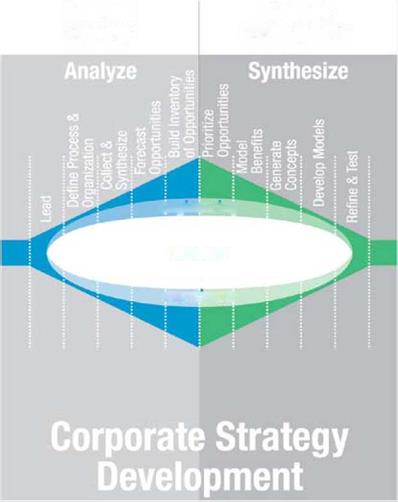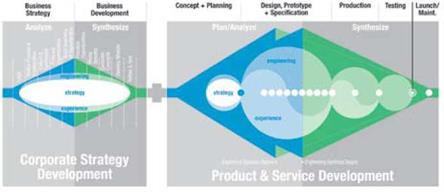For the purposes of this book, I will be referring to a development process for strategic innovation, currently rising in popularity and combining many of the best elements of those from the past. Through it, it’s easy to point to where sustainable criteria can best intersect the development of sustainable strategies, as well as products and services.
The qualities of this process are shown in two groupings: the development of corporate strategy (deciding what the organization should produce and offer) and the development of offerings (how best to create and deliver the offerings that meet an organization’s strategic goals). See Figure 16.1.
It’s important to note that it is the combination of these two phases that is most powerful to integrate sustainability into an organization. Doing so only in the strategy portion (and failing to communicate these strategies throughout the rest of the company) results in offerings that are not only less sustainable (in all aspects) but also have products, services, and events that
aren’t aligned with the purposes and direction of the organization. Likewise, implementing sustainability principles only within the development process may yield slightly more sustainable offerings but will miss opportunities to truly innovate solutions that shift paradigms and create more competitive, differentiable, and sustainable systems.
Both of these phases also include an analysis period in the beginning (shown in Figure 16.1 in blue) and a synthesis period in the last half (shown in the figure in green). While the exact activities in each may differ, there is a similar process of investigating context and opportuni-
|
FIGURE 16.1. http://flickr. com/photos/rosenfeldmedia/3272505917 Strategic innovation requires involvement between both strategy and development. |
ties (analysis) and then determining those best suited to the organization, strategy, and offerings (the synthesis). The synthesis portion of the strategy phase ends with the building and articulating of an organization’s strategy. In the development phase, the result is the building of the actual offerings, whether product, service, event, or some combination of all of these.
Note that there is a slight shift between the point at which analysis turns to synthesis in the development phase. This is because it’s critical that the front-end (user experience) synthesis begin before the back-end (technical synthesis does). This allows decisions about the customer experience to drive technical implementation decisions, instead of the opposite (which is the source of many inadequate solutions that come to market).
Some of the aspects of the other processes inherent in this one include the following: [70]
municated before offerings are developed if these offerings are to meet these objectives. Also, while engineering (or technical) research development can start almost immediately, key decisions about these aspects of the solution shouldn’t be made until the customer research and front-end development (the experience) is decided in order to ensure that the back-end will adequately support the intended experience. Similarly, some production and testing of well-understood components can begin early, but it’s usually less efficient to perform the majority of these steps until the final solution is defined and built. Otherwise, much of the production and testing must be redone every time significant changes are made. [71] truly effective (and not merely efficient) is being sure that the desire for fast results and the ability to iterate don’t cause technical decisions to pre-empt customer experience decisions on the grounds that the work can be fixed later (it won’t be), or that it’s too late since those aspects of the engineering have already been completed (which only ensures that the engineering department will efficiently create an unsuccessful offering).
• Skunkworks: It’s always important to involve all aspects of an organization’s activities in the development of offerings, particularly in terms of sustainability. Even if representatives from all departments aren’t on the development team fulltime, regular check-ins and feedback will help ensure that what seems like an innovative solution in one aspect doesn’t create insurmountable problems in another. Also, separating a multidisciplinary team from the rest of the organization in order to concentrate on development—particularly if the corporation’s culture doesn’t support innovation well—can often increase both efficiency and effectiveness in terms of innovating systems-oriented offerings, but it’s critical to specifically incorporate ways of documenting and sharing the learning within the team so that it can be shared effectively with the rest of the organization. This learning is at least as important to an organization as the final product or service—if not more so.
• “Genius Design:” It never hurts to have sharp people on a project—it’s preferable, in fact. Some team members have natural talents in looking at a complex challenge and seemingly pulling miracle solutions out of thin air. This is an asset but one that must still be validated along the way, both with customer and operational requirements— not to mention from a lens of sustainability.
Integrating the best of all of these processes isn’t easy, but this is the most effective way to work for many organizations. Now that I’ve described the various parts of the process in general terms (and most readers should see many similarities with the processes they already use and experience), we can address how to integrate sustainability strategies and techniques into these steps.
The Strategy Phase
In some ways, this is the most important phase in sustainable development because it is here that the most change can be made, both in terms of what an organization creates and offers as well as in how it informs and motivates the rest of the organization to integrate sustainable principles in every aspect of its operations. See Figure 16.2.
 Business
Business
![]() Development
Development
engineering
strategy
experience
FIGURE 16.2. http://www. flickr. com/photos/rosenfeldmedia/3264840173 Innovation strategy involves analysis that widens possibilities and synthesis that narrows them to the best strategies.




